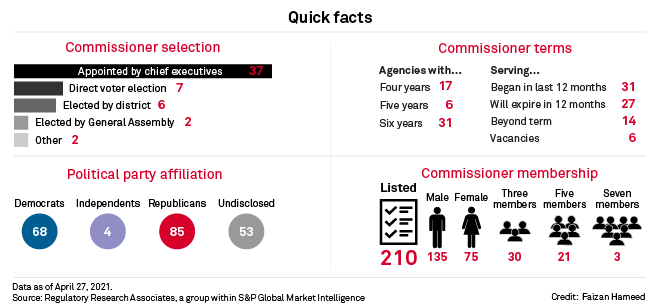S&P Global Offerings
Featured Topics
Featured Products
Events
S&P Global Offerings
Featured Topics
Featured Products
Events
S&P Global Offerings
Featured Topics
Featured Products
Events
Banking & Capital Markets
Economy & Finance
Energy Transition & Sustainability
Technology & Innovation
Podcasts & Newsletters
Banking & Capital Markets
Economy & Finance
Energy Transition & Sustainability
Technology & Innovation
Podcasts & Newsletters
S&P Global Offerings
Featured Topics
Featured Products
Events
Blog — 11 May, 2021
State utility commissions are quasi-judicial agencies that were created to, among other things, oversee the rates charged by electric, gas and water utilities, which are essentially government-sanctioned monopolies. At the federal level, the Federal Energy Regulatory Commission plays a similar role.
Maintaining constructive relationships with regulators is key to utilities' financial performances. The tenor of these relationships can be greatly impacted by the method and timing of the selection of individuals to serve on these agencies. Of the 54 regulatory commissions followed by Regulatory Research Associates, a group within S&P Global Market Intelligence, members are appointed in 39, while members are elected in some fashion in 15.
All else being equal, there is a greater degree of investor risk to jurisdictions in which commissioners are elected rather than appointed. Generally, energy regulatory issues are less politicized when they are not subject to debate in the context of an election. Realistically, a candidate for commissioner who is sympathetic to the utilities and/or appears to be amenable to rate increases is not likely to be popular with the voting public. A high degree of turnover can also make for increased regulatory risk.
Commissioners serving at 35 state-level utility regulatory agencies nationwide are selected by the state's governor; in Washington, D.C., commissioners are selected by the mayor. The U.S. president selects the members of the Federal Energy Regulatory Commission. In two jurisdictions, Massachusetts and Tennessee, commissioners are appointed by individuals other than the chief executive of the jurisdiction.
The commissioners at seven agencies are selected through statewide direct voter elections, while commissioners in six jurisdictions are elected by district. Commissioners in two jurisdictions, South Carolina and Virginia, are elected by the General Assembly.

Various trends regarding utility commissions
Commission composition — Within the past 12 months, 31 commissioners began serving new terms. Within the next 12 months, 27 commissioner terms are set to expire. Fourteen commissioners are serving beyond their term expiration dates, and there are six vacancies. Several appointments have been made; however, the appointees may not begin serving until they are confirmed by their respective state Senate.
Party affiliation — Within the 54 commissions specified in this report, 85 commissioners are Republicans, 68 are Democrats and four are independents. There are 53 commissioners who do not disclose their political affiliation.
Commissioner selection — Commissioners serving at 35 state-level utility regulatory agencies nationwide are selected by the state's governor. In Washington, D.C., commissioners are selected by the mayor. The president selects the members of the Federal Energy Regulatory Commission. Commissioners in two jurisdictions are elected by the General Assembly. The commissioners at seven agencies are selected through statewide direct voter elections, while commissioners in six jurisdictions are elected by district. At 28 state agencies, including Washington, D.C., and at FERC, the chairman is designated by the chief executive of the jurisdiction.
Commissioner membership — A total of 216 commissioner positions are encompassed within the 54 commissions followed by RRA. There are 30 three-member commissions, 21 five-member agencies and three seven-member bodies. In 17 agencies, commissioners serve four-year terms. Commissioners serve five-year terms at six agencies. In 31 agencies, commissioners serve six-year terms. As of April 28, there were 210 commissioners serving nationwide, as listed in this report.
For further details on the various utility commissions, our Market Intelligence Energy users can login and refer to the Topical Special Report issued May 3.
Our Market Intelligence Energy users can also obtain the corresponding data tables available here for a complete listing and an overview of the selection processes at state and federal utility regulatory agencies, including the D.C. Public Service Commission and the New Orleans City Council. The tables are current through April 28.
Miscellaneous changes
Changes to several utility commissions may occur in the near future as states look to modify the agencies' compositions.
During the 2020 general election, voters in New Mexico passed Constitutional Amendment 1, which changes the New Mexico Public Regulation Commission, or PRC, from a five-member body composed of elected officials to a three-member body consisting of commissioners appointed by the governor. State senate confirmation of gubernatorial appointments will be required. The appointed commissioners are to serve six-year staggered terms and are ineligible to serve more than two consecutive terms. The amendment also changes the terms of two commissioner seats that were up for election to two-year terms from four-year terms. As such, all terms of the elected PRC commissioners will conclude in December 2022. In addition, the terms of the initially appointed three-member commission seated in 2023 are to be two, four and six years so the subsequent six-year terms will be staggered.
In a New York Public Service Commission meeting, the commissioners adopted a resolution requesting that Gov. Andrew Cuomo, a Democrat, expand the PSC membership to seven from five. In accordance with state law, the term of any additional commissioners would be six years from February of the calendar year in which the commissioner is appointed. Cuomo has yet to act upon the request.
There has been a vacancy on the Pennsylvania Public Utility Commission since then-Commissioner Andrew Place resigned in April 2020 at the end of his term. Gov. Tom Wolf, a Democrat, named a replacement in November 2020, and the Senate failed to act on the nomination during the 2020 session. Wolf nominated the same individual again in January 2021, but on April 21, 28 members of the Pennsylvania Senate sent a letter to Wolf indicating that the Senate would not act on any gubernatorial appointment to fill a vacancy on the PUC unless or until the governor rescinds administrative actions he has taken to implement clean energy policy, including entering Pennsylvania into the Regional Greenhouse Gas Initiative.
In March, all three of the previous Public Utility Commission of Texas regulators resigned following criticism leveled at the PUC and the Electric Reliability Council Of Texas Inc. by Lt. Gov. Dan Patrick and others in the aftermath of a severe February weather event that led to power outages and price spikes in the ERCOT region. Since then, Gov. Greg Abbott, a Republican, has appointed and the Senate has confirmed Republicans Peter Lake as PUC chairman and Will McAdams as a commissioner. There is also a vacancy for the third spot on the PUC, previously held by former Chairman DeAnn Walker. That term extends to Sept. 1. It is unclear when the governor will name a third PUC member or whether the governor will nominate that person to fill only the remainder of the unexpired term or both the remainder of the unexpired term and a new full six-year term.
Both houses of the Legislature have considered several pieces of legislation that would alter the market structure as well as the makeup of the PUC and ERCOT.
Webinar

